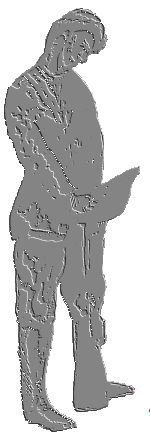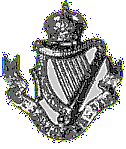 |
THE IRISH IN UNIFORM
THE CONNAUGHT RANGERS |
 |
Men of the 5th. Battalion, Connaught Rangers, with prisoners 1915 (IWM) |
| The Connaught Rangers were formed from
two original regiments, The 88th. and The 94th. Regiments
of Foot. Two regiments bore the number 88 until in 1793 a
third was raised and became known as The Connaught
Rangers. The first 88th. was the Royal Highland
Volunteers, known as Campbell's Regiment, raised in 1760.
The second was the 88th.Foot, known as Keating's
Regiment, which was in existence from 1779 to 1783. The
Connaught Rangers were, of course, raised in Ireland's
Western Province of Connaught. Their badge from the time
of their formation was the Irish Harp. The 88th.'s first
Battle Honour was gained during the Egyptian Campaign,
and the following additional Honours were gained during
The Penisular War :- 'Talavera', 'Busaco', 'Fuentes
D'Honor', 'Cuidad Rodrigo', 'Badajoz', 'Salamanca',
'Vittoria', 'Nivelle,' 'Ortez', 'Toulouse', and
'Peninsula'. The 88th. Regiment after The Pernisula War was stationed on the island of Corfu in 1834, and received new colours incorporating its Penisula War Honours, from Lady Woodford, wfe of Major-General Sir A. Woodford on 27 February. The regiment served in The Mediterranean, The West Indies and North America until 1851, and after spending 3 years in England departed for active service in The Crimean War in 1854. During that campaign, The 88th. Regiment took part in the battles of Alma and Inkerman, and the seige of Sebastopol. It then reurned to England for a brief time and then embarked for India. Before embarkation, during the troops' English sojourn, new colours were presented at a parade on Southsea Common in July 1857 by Sir William Codrington. The 88th. Regiment took part in the campaigns during The Indian Mutiny, and gained the Battle Honour "Central India" during that time. The Regiment did not return to England from India until 1870. It then saw active service in South Africa,during the Kaffir War from 1877 to 1878 and the Zulu War of 1879. For bravery in action on 29 December 1877 near Komgha, when he attempted to save the life of a member of the Frontier Armed Mounted Police, Major H.G. Moore of The 88th. was awarded The Victoria Cross. Details of his action can be found on The Victoria Cross Reference website, reached via the Links Page on this website. Following the campaigns in South Africa, the 88th. Regiment transferred back to India in 1879 and 1880 and remained there until 1891. At Mooltan in 1881, the 88th Regiment of Foot was re-named as the 1st. Battalion of The Connaught Rangers, and joined with the 94th.Regiment, which became the 2nd. Battalion. At Meerut in 1885, the Duchess of Connaught presented new colours to this Battalion of the new regiment. The regiment which became the 2nd. Battalion of The Connaught Rangers was the 94th. Regment of Foot. The first two regiments to be known by this number were in existence from 1760 to 1763 and from 1779 to 1883. The third was in 1793, an Irish Corps raised by Colonel The Honourable J. Hely Hutchinson, later the Earl of Donoughmore. This regiment became part of The Duke of York's Army, and in the year follwing its formation, its men were dispersed into other units. In place of this 94th. regiment, King George III in 1793 commanded that a new regiment be raised in Glasgow, Scotland by officers with previous experience with the Old Scots Brigade in Holland. This 94th. regiment was a Highland Corps and wore the Mackay tartan. It served in Gibraltar from 1795, The Cape Province (South Africa) from 1796, and in India from 1798 to 1807. In 1808, then 94th. returned to England and recruited new troops before taking part in campaigns on The Continent of Europe in Portugal, Spain and France. In 1814, The Highland Corps 94th. Regiment returned to England in 1814, then went to Ireland and was disbanded in Belfast in 1818. A new 94th. regiment was then raised in Glasgow, which went to Gibraltar soon after its formation. In 1837, the 94th. were stationed in Birr Barracks, County Offaly, Ireland (then known as Queen's County). New colours were presented to the 94th. in 1862 at Jullundur by Major-General Sir Sidney Cotton. The regiment returned to England in 1868, and then spent 10 years on Home Service in The British Isles, mostly in Ireland. FRom 1879 to 1882 the 94th. saw service in Zululand, the South African Transvaal and The Boer War. Three men of the 94th. regiment won the Victoria Cross for heroism during the campaigns in South Africa. Private Thomas Flawn and Private Francis Fitzpatrick were awarded the V.C. for on 28 November 1879 saving the life of a Lieutenant of the First Dragoon Guards under fire when their native troops and bearers deserted. Lance-Corporal James Murray of Cork City was awarded The Victoria Cross for saving a severely wounded Private at Elandsfontein on 16 January 1881, during which gallant escapade he washimself severely wounded. The 94th. Regiment returned home in March 1882, having whilst abroad been designated the Second Battalion of a new regiment The Connaught Rangers, the First Battalion of which was formed from the previous 88th.Regiment. From Ireland in 1888 the Second Batalion of The Connaught Rangers went to barracks in Portsmouth, England; before going to Malta in 1889. In 1891, the First Battalion of The Rangers returned from service in India, spent several years in England and then in 1899 went to South Africa as part of an Irish Brigade under the command of Major-General Hart. Casualties in The South African Campaign were heavy, and the First Battalion returned to Ireland to recuperate, re-train and recruit until 1908. In 1908, the First Battalion embarked for India. Shortly afterwards, the Second Battalion returned from its tour of duty on the Indian sub-continent to be stationed in Tipperary Town Barracks from 1908 to 1910. Both battalions of The Connaught Rangers received new colours from King George VI in 1911, the 1st.Battalion at that time being in Delhi, India, and the 2nd Battalion in Dublin, Ireland. From 1908 to 1910, the 94th. Regiment had been quartered in Tipperary Town Barracks, County Tipperary. At the outbreak of The First World War in 1914, the 1st. Battalion of The Connaught Rangers was in India and the 2nd. Battalion was in Aldershot Barracks, Hampshire, England. The 1st. Battalion was recalled from India, and joined with the 2nd. at Le Touret, near Bethune. These two regular battalions of The Rangers served together for the entire 1914-1918 War. During that war, the Rangers' strength was supplemented by the 3rd. (Reserve) Battalion, the 4th. (Extra Reserve) Battalion and the 5th. & 6th. (Service) Battalions. After serving on The Western Front in France during 1914 and 1915, the 1st. and 2nd.Battalions in December 1915 embarked for The Middle East theatre of war, where they saw service in Palestine, Mesopotamia and Turkey. Their place on The Western Front was taken by the 6th. Battalion, which fought in France and Flanders (Belgium) until The Armistice in November 1918. In October 1916, Private Thomas Hughes of Carrickmacross, County Monoghan, was awarded The Victoria Cross for his action in single-handedly putting out of action an enemy machine gun and taking several prisoners. Details of his citation can be found on The Victoria Cross Reference website, reached via the "Links Page" of this website. The Firrst World War Battle Honours of The Connaught Rangers are:- 'Mons', 'Retreat from Mons', 'Marne 1914', 'Aisne 1914', 'Messines 1914, 1917', 'Armentieres 1914', 'Ypres 1914, 1915, 1917', 'Festubert 1914', 'Givenchy 1914', Neuve Chapelle', 'St. Julien', 'Aubers', 'Loos', 'Somme 1916, 1918', 'Guillemont', 'Ginchy', 'Cambrai 1917, 1918', 'St.Quentin', 'Bapaume 1918', 'Hindenburg Line', 'Selle', 'France and Flanders 1914-1918', 'Kosturino', 'Struma', 'Macedonia 1915-1917', 'Sulva', 'Sari Bair', 'Scimitar Hill', 'Gallipoli 1915', 'Gaza', 'Megiddo', 'Sharon', 'Palestine 1917-1918', 'Tigris 1916', 'Kut al Amara 1817', 'Baghdad', 'Mesopotamia'. Outside military circles, the 'claim to fame' of The Connaught Rangers which is best-known worldwide is their singing of their favourite marching song "It's a Long Way to Tipperary". The 2nd. Battalion sang this song on 13 August 1914 as they marched in parade order through the streets of the French port of Boulogne on their way to The Front as part of The British Expeditionary Force. This incident was witnessed by War Correspondent George Curnock, and his report of it was printed in The Daily Mail Newspaper on 18 August 1914. From that day, that music-hall song, written by Jack Judge in 1912, gained popularity amongst all the troops during The Great War and gave lasting fame to the town of Tipperary, Ireland. (The story of this song is shown on its own special pages on this website, reached via the Main Index Page and the Site Map.) After World War I was over, both battalions of The Connaught Rangers returned to the Army Depot at Dover, Kent, England; where their numbers were made up to full strength once more. The 1st. Battalion then went to India in October 1919; and the 2nd. Battalion went to Upper Silesia (Poland) in May 1921. When news of the atrocities committed in Ireland by "The Black and Tans" reached the 1st. Battalion in Jullundur and Solan, India; a mutiny arose amongst the Irish troops and 69 men were court-martialled. At Solan, 2 mutineers died whilst attacking the armoury, and 14 were sentenced to death. However, only the ring-leader of this rebellion, Private J. Daly, was finally executed. No doubt the Army leadership realised the extreme provocation under which the rebellion was mounted by those Irishmen, hearing of the fate of their fellow-Irishmen at home at the hands of British soldiers of another regiment. Following the mutiny, the entire 1st. Battalion was sent to Rawalpindi and saw service there, with no further rebellion. In June 1922, both the 1st. and 2nd. Battalions returned to Britain. Their colours were then laid up at Windsor, Berkshire. The Connaught Rangers were disbanded as a regiment on 31 July 1922, after an outstanding record of uniformed military service over almost 230 years. The Rangers' links to Tipperary Town still exist, immortalised worldwide in the words and music of the song "It's a Long Way to Tipperary". |
| Use this button to go to the Navigation Buttons at the top of this page. | |
This
site webcrafted for The Fame of Tipperary Group,
Tipperary Town, County Tipperary, Ireland by the The WebWizards© at The
Plug-in Office ®,, e-mail to plugin@iol.ie All text, backgrounds, graphics, images Copyright © 2000 The WebWizards or as acknowledged. |
|